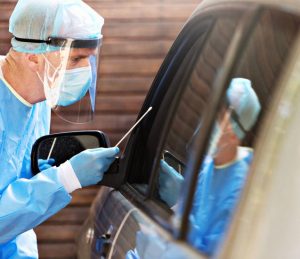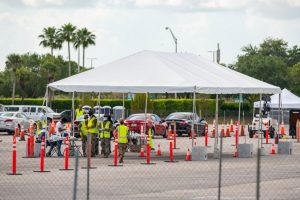One sure way through the COVID-19 pandemic involves testing and contact tracing at an unprecedented level.
In many parts of the world and in an increasing number of states, the testing solution has been to implement drive-through testing centers. Safer for both patients and nurses and faster than office visits, you can expect to see this type of testing facility popping up in your area soon too… and if you’re an advanced practice nurse you may even be responsible for putting the whole thing together.
This kind of testing isn’t something they teach in nursing school, not even at the master’s or doctoral level for APRNs. That means you are having to learn as you go, and best practices are being developed and distributed on the fly:
- Select an accessible site
- Design signage and traffic flow for throughput and safety
- Coordinate with local public safety and law enforcement
- Develop a communication strategy for informing the public about the site, how to access it, and regarding any limitations (testing restrictions, hours, etc)
- Ensure access to plentiful testing and safety supplies
- Ensure site provisioning for storage, electrical, and other needs
- Design robust and secure data collection systems
- Train staff in three important processes:
- Traffic control
- Screening
- Testing
A New Challenge In Mass Testing Requires Innovation in Methods

While various tests and testing methods are still under development, the most common and effective PCR (polymerase chain reaction) test typically involves the insertion of a sterile swab through the nasopharyngeal passage to collect a sample for analysis. The sample goes into a liquid-filled test tube for transport to the lab.
It’s both uncomfortable and difficult to perform the sample collection for non-medical personnel, while healthcare professionals themselves risk both exposure and becoming overwhelmed by the sheer number of people that need to be tested. There’s also the risk of sampling sites becoming centers for the spread of infection as both infected and current uninfected people gather there for testing.
A compromise that many countries and regions have hit on is the drive-through testing center. By keeping potentially infected individuals in their cars, more protection is offered to both healthcare providers and other people arriving for tests. At the same time, a nurse can supervise as the patient self-collects the sample, ensuring they are inserting the swab deeply enough and long enough to get a good collection without injuring themselves. In other cases, nurses may administer the swab test directly.
Hundreds of patients a day can be tested through these facilities, greatly accelerating the testing process and offering the option to use contact tracing as a method for controlling the spread of the virus rather than hasty and costly blanket lockdown orders.
What Is The Official Status of Drive Through Testing Sites?
In cases where nurses administer the swab directly, the parking lots where the tests take place would fall under the exact same regulations as a patient care room within the walls of the hospital. This means the process is fully sanctioned by the FDA and state regulators.
Normally, self-administered tests, where the patient takes their own sample, are prohibited by the FDA. Recognizing that healthcare professionals were becoming overwhelmed with testing demand alongside treatment needs, but still wanting to avoid the wild-west of at-home self-testing, the FDA authorized supervised self-collection in late March. That makes drive-through sites using either process fully authorized.
Preparing Your Drive Through Testing Facility

The most important part of establishing a drive-through testing facility will come in the preparation phase. Ensuring that your site layout, organization, supply management, and procedures are lined up properly will go a long way toward making the effort a success.
Communication Setup
Both within the team and with the public, both pre-arrival and on-site. Have a clear and consistent message to offer patients attending and answers for common questions about follow-up, privacy, and other likely issues.
Team members at different positions within the test site will need a way to communicate clearly about traffic flow, patient concerns, or other mundane operating information. Provide radios, a group text facility, or other solutions to expedite these messages.
Equipment and Supplies
Your site will need the appropriate numbers of all the typical testing and personal protective equipment, along with a few items you might not have considered. The basic equipment will include:
- Swabs
- Personal Protective Equipment
- Gowns
- Gloves
- Goggles or face masks
- N95 masks or respirators
- Reflective vests
- Surgical drapes
- Universal Transport Media
- Biohazard bags
- Emesis bags – Some percentage of people who have a long swab shoved through their nose and into their throat are going to have their gag reflex provoked and vomit. Be prepared for this with an adequate supply of emesis bags handy at every station! It’s also important to train staff to be ready for this eventuality so they can be quick on the draw and avoid getting splashed.
- Gauze – Similarly, errant sticks can provoke nosebleeds; be prepared to manage these events as well.
- Flashlight – Testing may or may not be done after dark, but with the first swab dropped down between door and seat, you’ll be glad you made sure staff have flashlights.
- Clipboard/Data collection equipment – Paper records and labels may not be the best choice for collecting patient data but they don’t break; either way, you’ll need clipboards, laptops, or tablet computers at a minimum to record data.
Logging/Data Collection
You’ll have to decide how to collect information on patients coming through for testing to ensure that samples and the person who they were taken from can be matched up if the test returns positive. The process also needs to meet all HIPAA standards for patient data.
In some cases, contact tracers have been hampered getting in touch with infected individuals because of illegible information handwritten on data sheets. Healthcare workers are somewhat infamous for their handwriting issues, so it’s important to have an electronic means of capturing personal data, or double-checks of written records.
Physical Site preparation
In most cases, a cleared parking lot is the easiest and best place to set up a drive-through testing site. But nurses can get creative as long as the minimum requirements are met.
The site should be able to:
- Accommodate the expected flow of patients
- Do so without safety concerns for either patients or staff in terms of vehicular traffic
- Not impede either public roads or access to other facilities at the site
Depending on local and seasonal weather conditions, consider setting up tents or tarps to shield staff and patients during the test. Space heaters may be provided to keep staff warm. Also consider provisions for hygiene and bathroom access.
Consider also offering non-drive-through options for potential patients who do not have vehicles or are uncomfortable driving through your site (elderly drivers, for example, may be concerned, quite rightly, about driving in close proximity to pedestrians—pay attention to those concerns!).
The site will have to be laid out in a way that facilitates large numbers of people passing through safely both on foot and by car. Mixing the two can be hazardous. The site should also be prepared with:
- Signage – Clear way finding marks for both staff and visitors
- Air flow considerations – If possible, it may be desirable to create an air curtain between patients and staff, further reducing the likelihood of contamination
- Lighting – The area will need to be well-lit during all testing hours
- Refrigeration – Some test media may require refrigeration after collection and before lab transport
- Electricity – Both of the above requirements may necessitate some electrical supply, either from nearby structures, or using on-site portable generators.
- Waste collection – Dealing with volumes of potentially contaminated waste from drive-through sites requires special consideration as well. Large, lined trash cans distributed liberally among the testing stations are important.
Train Staff to Standards
It should go without saying that you must train your staff in all of the above processes and procedures prior to opening the site. It’s a new process for everyone. Ongoing support will be essential so each shift should have someone working who has had more in-depth training on every subject.
Operating Your Drive-Through Testing Facility

Protocols published by the Department of Health and Human Services Assistant Secretary for Preparedness and Response Technical Resources, Assistance Center, and Information Exchange (APSR/TRACIE) suggest adopting incident command system (ICS) for organizing drive-through test sites. If you are not familiar with ICS, your facility security team or disaster response committee should be able to offer an overview. The system offers a ready-made organizational pattern to follow that will keep you from having to reinvent the wheel.
There are three basic functional areas that you’ll need to conduct operations, each with different roles and PPE requirements:
1. Traffic Control
PPE required: Minimal (fluorescent vest)
Many test sites will have multiple lanes and multiple collectors. A clear, well-marked, and manually directed traffic flow will be necessary to balance cars through these lanes. Coordination may be necessary with local law enforcement if your test site backs out onto public roads. Alternatively, your site security team may have members experienced in managing traffic flows.
Prepare the site for both adequate incoming and outgoing traffic. Nothing is worse than having your staff sit idle while people wait to get in because already tested cars don’t have a clear exit.
Ensure adequate signage is displayed both on and off site, accounting for traffic speeds and turning decision points. Since you’ll be operating in an ad-hoc area, you can’t expect anyone to be familiar with how to access the site—make sure you have clear directions, both as they approach, and when publishing notices announcing the site.
2. Screening
PPE Required: Moderate (face masks)
Screening is where data is collected on the patients and any other requirements are confirmed (such as in areas where testing is still limited to those exhibiting symptoms).
If your site requires appointments, screening will also be where these are confirmed.
Depending on local testing restrictions, you may need to filter out people who show up but are ineligible for testing. Have an exit that bypasses your testing lanes for this purpose, or even just for people who made a wrong turn into the site.
Screeners will collect personal information and generate labels for tests. Depending on your data collection and entry process, it might be smoothest to use teams of two, one to interact with the patient and the other to record the information.
3. Collection
PPE Required: Full for swabber (face mask, gown, gloves, face shield); moderate for prepper (face mask, gloves)
Collection can be handled by a single professional where patients will be self-administering the swab; that person should wear full PPE nonetheless, in case of issues that come up requiring direct contact.
In other cases, it’s best to have a two-person team at the collection point. The swabber, who administers the swab test, wears full PPE; the prepper, who assembles the clean test kits and materials to hand off and confirms data. The prepper can also act as a PPE spotter to enhance the safety for the swabber. In all cases, the swabber should restrict their movements and contacts to potentially infected media and individuals, while the prepper deals only with clean items and areas. This reduces the need for PPE donning and doffing.
The process itself can run quickly and smoothly when the car pulls in:
- Validate personal data on the test for confirmation
- Explain the procedure
- Collect the specimen
- Verify the data again
- Bag and store the tagged specimen
After the test is completed, the car will be directed to the exit and the next one can enter the testing space.
In South Korea, which has mastered the drive-through testing method, the entire process can take as little as ten minutes. With the proper preparation and technique, you can operate a test site that runs faster and is safer for everyone involved than a traditional office visit.


